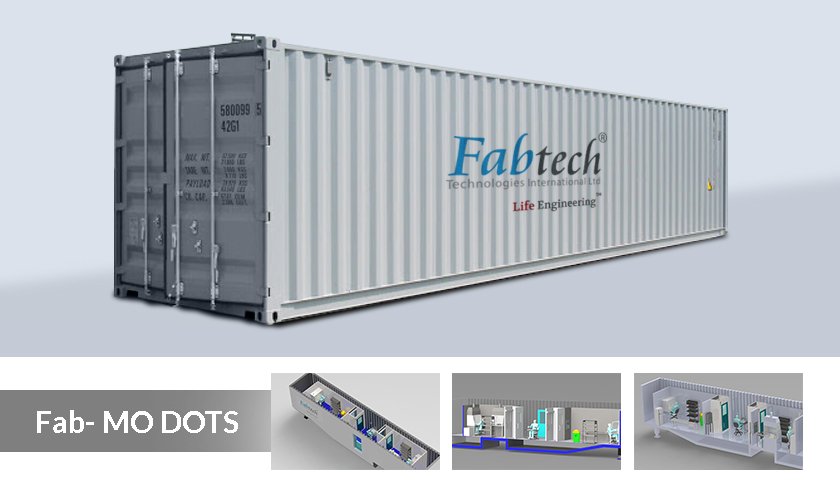How can Mobile BioContainment Laboratory (Fab- MO DOTS) help you overcome low testing during a pandemic?

- A few of the significant concerns are
- How to contain the spread of the disease?
- Lack of availability of Test-kits for COVID-19
- Pressure on the healthcare system and
- Lack of Infrastructure for testing potential patients
Globally very few countries invest in public healthcare. Coronavirus testing is the key to resuming normal life that is currently standstill due to the lockdown measures even after relaxation. Continuing services without proper testing could trigger revive and spike COVID 19 cases causing deaths and crash of the healthcare system. Countries, where the density of population is higher, makes it even more difficult for testing the community. Adding to the woes is the turnaround time!
Mobile Biocontainment Laboratory is an ideal solution in this scenario as it can help to meet the surge capacity for laboratory services during emergency times like these. These facilities can facilitate in carrying out COVID 19 testing without any delay, be it high-density areas, red zones or anywhere across the country.
A fully equipped Mobile Biocontainment Laboratory will be able to help in increasing the screening and testing volume handled by the facilities without affecting the existing laboratories. These laboratories are designed, engineered and constructed according to the CDC BMBL 5th edition guidelines for BSL II and WHO guidelines for BSL laboratories.
Features of Mobile Biocontainment Laboratory
The manufacturing of these Micro Biocontainment laboratories conforms to the NIH CDC Biosafety in Microbiological and Biomedical Laboratories (BMBL) 5th edition guidelines for BSL-2.
The Mobile Containment Laboratory is similar to most types of containment laboratories. The purpose or the activities conducted in the MBL determines the design of the laboratory, including the safe-handling of biologically contaminated materials. Design features include standard enhancements like supply and exhaust air HEPA filters, anterooms safeguarding the operators, samples integrity and security while moving samples within the laboratory and the environment.
The challenges of an emergency pandemic situation like COVID-19 requires that we minutely pay attention to the workflows to ensure optimum efficiency. The laboratory is carefully designed after understanding the workflow operation to facilitate an efficient workflow. The outcome includes
- designated work zones in the laboratory that offer HEPA filtered supply air in each work zone,
- primary containment devices for safe sample flow and,
- meticulously installing SS work stations, supply & storage areas, gowning bench, pass boxes for material transfer.
The chain of custody procedures is crucial while transferring the sample material from common or command areas into the laboratory working zones through material transfer pass boxes.
Work Zone Description
The entire laboratory is divided into several zones as following for effective execution of the workflow.
1. Common or Lab Command area
This area functions as a chain of custody procedures from the main entrance to the mobile biocontainment laboratory leading to the gowning area and material transfer to the PCR and BSL II+ areas with two material dynamic pass boxes for material transfer.
2. Gowning Areas (also known as Anterooms)
These rooms are at relatively positive pressure to the command centre and work as an additional barrier to the BSL laboratories. Additionally, it serves as a gowning area for personnel before entering to the BSL work zones, equipped with crossover or gowning benches and a handwash sink. PPE storage shelves with a UV lamp at the entry and exit doors of the Anterooms have pressure monitoring devices for differential pressure monitoring. Both entry and exit doors are interlocked to eliminate the cross-contamination through the anteroom.
3. PCR Preparation Area
The area is designed as per the guideline for BSL-2 laboratory. The lab area is provided with one PCR work station of suitable size, one refrigerator (4°C) and freezer (-20°C) including HEPA filters that supply and return air from the laboratory area. All the essential laboratory furniture like storage shelve and stools will be of stainless steel (SS).
4. BSL II + Laboratory area
In BSL II + area, both supply and exhaust air is HEPA filtered. The laboratory area is provided with class II type A2 Bio-safety cabinets in two numbers for protecting personnel and product, ensuring safe working space.
Systems
Fabtech’s MO DOTS (Diagnosis On The Spot) are equipped with Cleanroom systems that are designed and manufactured to deliver optimal heating, cooling and ventilation for lab operations that require superior contaminant control. We control the end to end process in-house – from design, engineering, installation, commissioning and qualification. Our systems are energy-efficient, low maintenance and meet the stringent regulatory requirements of all major global agencies.
Our inspired engineering, ingenious technology and problem-solving approach make us a formidable partner for any company into life-science applications.
Categories
Recent Posts
Subscribe
Never miss a post from Fabtech. Sign up to receive updates direct to your inbox.
